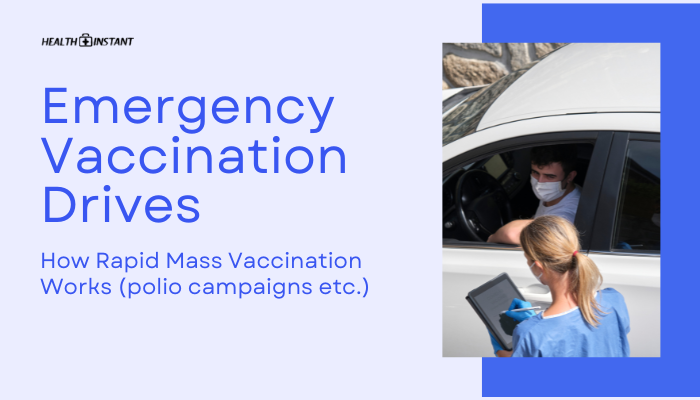Introduction
During disease outbreaks or when preventing resurgence of eliminated illnesses, emergency vaccination drives quickly mobilize to protect large populations.
From polio campaigns that reach millions of children in days, to urgent measles immunizations in crisis zones, these operations showcase the power of coordinated healthcare, logistics, and community outreach.
This guide outlines how rapid, large-scale vaccination efforts unfold, their components, and challenges, with polio eradication initiatives as a prime example.
Why Mass Vaccination Campaigns Are Necessary
- Disease Containment and Elimination
- Halt ongoing outbreaks or prevent them from spreading to adjacent regions.
- Protection of Vulnerable Groups
- Infants, elderly, or immunocompromised individuals often rely on herd immunity.
- Closing Immunity Gaps
- Some communities might miss routine immunizations due to access issues, conflicts, or cultural barriers.
Overall, large-scale drives deliver vaccines to entire populations at once, greatly accelerating coverage goals.
Key Components of Rapid Vaccination Drives
Planning and Coordination
- Government and NGO Collaboration
- Ministries of health, WHO, UNICEF, or local nonprofits coordinate resources.
- Clear Goals and Timelines
- Typically aim for extremely high coverage (e.g., 95% or more) within a few weeks.
Cold Chain and Logistics
- Vaccine Storage Requirements
- Many vaccines need refrigeration between 2°C and 8°C.
- Transport Strategies
- Insulated coolers, freeze packs, and refrigerated trucks maintain safe temperatures.
- Distribution Networks
- Plan routes to remote or urban areas with appropriate rest stops to keep vaccines cold.
Workforce and Training
- Health Workers and Volunteers
- Nurses, community health aides, students, or NGO members often staff campaigns.
- Standardized Protocols
- Identical guidelines (doses, injection sites, data recording) ensure uniform quality.
- Mock Drills
- Some campaigns hold practice runs to iron out logistics issues.
Community Engagement and Education
- Messaging
- Radio spots, local leaders, or flyers raise awareness.
- Addressing Vaccine Hesitancy
- Q&A sessions or door-to-door visits build trust, clarifying safety and importance.
- Social Mobilizers
- Volunteers who speak local languages, reassure families, and ensure children are present during vaccination visits.
Case Study: Polio Eradication Campaigns
Polio campaigns exemplify how swift and structured mass vaccination can hamper a virus’s spread and drive it toward global elimination.
House-to-House Delivery
- Door-to-Door Teams
- Volunteers carry polio vaccine in cooled carriers, offering drops to children under five.
- Marking Houses
- Chalk or paint marks used to indicate that the household was visited and children vaccinated.
- Rapid Coverage
- In a weekend or short timeframe, entire cities or rural areas can be blanketed.
Surveillance and Microplanning
- Data Collection
- Real-time tracking of which families were missed or which localities needed follow-ups.
- Booster Rounds
- Repeated vaccination visits to ensure no child is missed, especially in high-risk areas.
Benefits of Emergency Vaccination Campaigns
- Quickly Boost Immunity
- Mass coverage in a compressed period disrupts transmission chains.
- High Visibility
- Media coverage fosters public buy-in and promotes a sense of collective effort.
- Opportunity for Ancillary Health Services
- Sometimes used to distribute vitamins, deworming pills, or health info.
Challenges and Limitations
- Logistical Complexity
- Transporting vaccines to remote areas demands stable power supply or advanced cold boxes.
- Resource Strain
- Disrupts daily healthcare services if many staff shift to the campaign.
- Misinformation and Hesitancy
- Cultural or religious skepticism can hamper acceptance in certain communities.
- Security Issues
- Conflict zones or dangerous terrain may limit safe operations.
Future Innovations and Techniques
- Digital Tracking
- Apps help track real-time progress, mapping out unvaccinated households.
- Vaccines with Less Strict Storage
- Developing thermostable formulations can solve cold chain constraints.
- Community Partnerships
- Empowering local leaders, parents’ groups, or religious figures to champion immunization.
Conclusion
During outbreaks or for disease elimination campaigns, rapid mass vaccination stands as a cornerstone public health strategy. With robust planning, fluid logistics, and extensive volunteer engagement, these drives reach even the hardest-to-access populations.
Lessons from polio show that nearly eliminating a virus is possible with repeated, targeted campaigns. While challenges like supply logistics, suspicion, or political instability persist, continuing technological and community-level advances promise more efficient and inclusive vaccination efforts, forging global resilience against life-threatening pathogens.
References
- World Health Organization (WHO). (2021). Guidelines on mass vaccination campaigns.
- United Nations Children’s Fund (UNICEF). (2020). Polio eradication success and best practices.
- Centers for Disease Control and Prevention (CDC). (2019). Rapid response and immunization strategies.
- Gavi, The Vaccine Alliance. (2022). Innovations in vaccine distribution for emergent outbreaks.
Disclaimer: This guide is informational. Implementation details can vary regionally. Always follow local health authority advisories for official vaccination campaigns.

